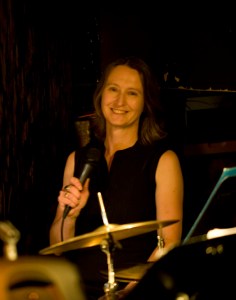
A 10-day celebration of female creativity, this year’s Melbourne Women’s International Jazz Festival is under way, at Bennetts Lane. Its artistic director, Sonja Horbelt, herself an acclaimed drummer and educator, shares her thoughts on gender imbalance, in what is arguably the most exciting name-dropping interview posted on this site.
AustralianJazz.net: How was the Melbourne Women’s International Jazz Festival born?
Sonja Horbelt: The MWIJF was instigated by Martin Jackson – of the Melbourne Jazz Co-op – in the late 90’s, because he felt there was a need to provide a week of gigs that highlights women’s contribution to the Melbourne jazz scene and provides inspiring role models for younger players.
AJN: What have been the festival’s highlights, so far?
SH: Satoko Fuji with the Bennetts Lane Big Band; Judy Bailey Quartet with double string quartet, recorded live for ABC; Emie Roussel Trio (Canada);
Trio Vehere (Norway); Katie Noonan with Paul Grabowsky cd launch of “Before Time Could Change Us”; Elana Stone and Michelle Nicolle double bill; West End Composers Collective (Brisbane); Cuban born Brisbane based pianist Marialy Pacheco; Salsista (Melb); Frøy Aagre (Norway); The Festival Sextet in various formations.
AJN: How do you select the artists featured in each year’s program?
SH: Budget determines very much what we can afford in terms of artists and then our task is to compile a program reflecting the diversity of talents within the scene. Whilst the aim of the festival is to promote female composers, bandleaders and instrumentalists, we’re inspired by all of the amazing performers and musical experiences the festival is able to showcase. It is important to present gigs that you wouldn’t necessarily see on a weekly basis, if possible. If funding permits, we often support new ensembles and projects that might not happen without the festival’s support. We see our festival as a launching pad for many artists, emerging, developing and established to move their work to the next level.
AJN: What has been the greatest challenge you had to face?
SH: Finding sufficient funding to stage the festival.
AJN: Have you had support from the state and federal cultural institutions?
SH: Along the way, yes: Apra, Arts Victoria, City of Melbourne, Australia Council, VCA – Melbourne University and corporate sponsors, like Fraser Place Apartments, Justitia Lawyers, Brolly Design, Fed Square, Melbourne Arts Centre – and Bennetts Lane and the Melbourne Jazz Co-op.
AJN: The mere existence of the festival, implies some sort of gender inequality, in the representation and acceptance of women as jazz artists. Is this the case?
SH: I think the imbalance lies very much in the number of female jazz musicians there are, or more the lack of.
AJN: What is the cause of this ‘imbalance’?
SH: I think the gender imbalance has happened in the past, because, for a long time, music has never been considered a career option for females in particular – certainly for me, as a drummer, my careers advisor at school never remotely entertained the thought of me pursuing music as a career, even though I also played piano. I was headed to becoming an academic, when I was sidetracked by a chance entry to the VCA.
Now there are more significant and very visual role models for younger female players – Sandy Evans, Andrea Keller, Tamara Murphy, Kellie Santin, Gian Slater, Nilusha Dassenaike, Monique Di Mattina, Michelle Nicolle, Nadje Noorhuis, Linda Oh, Zoe Hauptmann, Kristin Berardi, Kate Kelsey Sugg, Sarah Mackenzie, Nat Bartsch – and the VCE music syllabus is much more advanced. The rise of James Morrison’s Generations in Jazz Festival means that far more secondary students are exposed to jazz at an earlier age, and see it as a potential career path.
AJN: Is sexism an issue, in the Australian jazz scene?
SH: Sexism happens everywhere, not just in the jazz scene, as does racism and homophobia. In that sense, the jazz scene is simply a reflection of society in general. I think it’s important though to recognize that sexism and gender imbalance are not necessarily the same thing.
AJN: Who are your favourite female jazz artists?
SH: Maria Schneider; Hiromi; Dianne Reeves; as a drummer, I definitely have to say Terri Lynne Carrington and Cindy Blackman; and from our own community, Sandy Evans, Andrea Keller, Shannon Barnett, Nadje Noorduis, Nina Ferro, Michelle Nicolle, Kellie Santin and Sue Johnson. I could list more Australian musicians that I get to hear often and find inspiring and equally so many male musicians.
AJN: The Australian jazz community can boast to have many women among its ranks – and not only in the role of vocalist – compared to what seems to be the case in the US, or even Europe. Do you agree?
SH: I don’t think we do; I think that simply jazz was never a career option for women and that we’re still catching up to our male counterparts, in terms of numbers, but significantly this is changing, if you look at the number of female artists emerging from VCA, Monash, WAPA, Sydney Con, Queensland Con etc.
AJN: What is your biggest aspiration, regarding the festival?
SH: A higher level of more consistent funding; continuing to seek out the best and encouraging new projects and ensembles for artists at every stage of their career.



